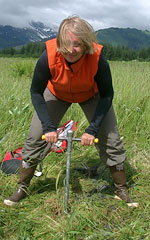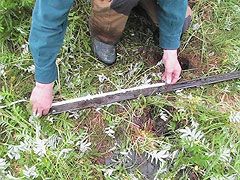

 | |||||||||||
|
|
Journals 2007/2008Louise McMinn
July 13, 2007 I am getting used to the summer light here in Alaska. Sunrise is about 4 am, but the light does not wake me until 5 am. Sunset occurs about 10:00, but everyone is tired from the long day and is getting ready for bed. Today I worked at Puffy Slough, a marsh not far from the Katella River. Ian was taking coring samples, looking for evidence for past earthquakes and uplifts in the area. This area of Alaska has experienced many plate collisions, causing earthquakes and altering the landscape dramatically. Some of the islands in the area are a result of the 1964 earthquake, which had a magnitude of 8.4. The area that we were studying, just east of the Copper River Delta, is generally an area of uplift. The coring instruments were quite simple, consisting of 6 meter long rods with a corer at one end. It was a lot of work sinking it into the marsh by hand! Ian and Ron did most of the work, while I took the role of supplying the tools. We were lucky that after our first few cores we found a layer of peat between the silt and sand. This gave evidence that there were enough trees and other vegetation in the area to decompose, and that they were covered over by layers of silt and what is now a large marsh.
Ian measured and recorded the results of all of the samples. We generally went down five to six meters in each location. Sometimes we just found layers of silt, but we soon found what he was searching for - a second layer of peat! This showed that there was most likely another major geological event that occurred many years ago. We wrapped one sample for further investigation in the future and took a few peat samples to be carbon dated.
In the afternoon we flew to another part of Puffy Slough. Upon landing, we noticed evidence of bears in our location, so we were alert. I learned how to load and unload a shotgun, although I knew I could not be counted on to use it. I am learning that field scientists have to be prepared in many areas . |
||||||||||

